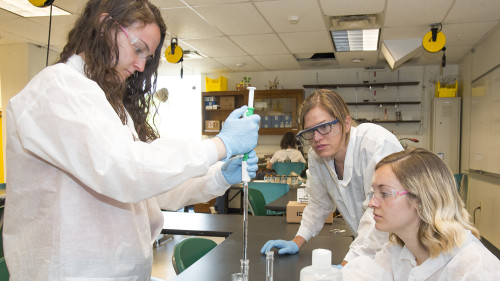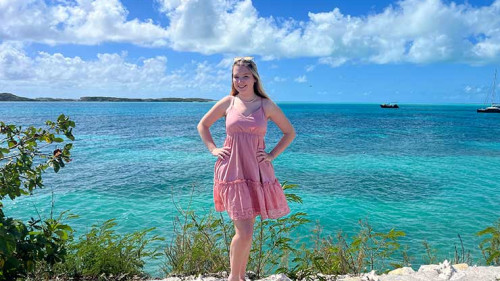
Austin. Ants. A-game research.
Rebecca Clark, Ph.D., assistant professor of biology, and two of her students traveled to the Texas capital last week for the annual meeting of the Society for Integrative and Comparative Biology (SICB). Clark, together with Savana Goslovich ’23 and Cassandra Smith ’24, presented a poster about their research on leafcutter ants and how fiber consumption can affect a colony.
SICB fosters research, education, public awareness and understanding of living organisms from molecules and cells to ecology and evolution. The Siena team’s study fit the bill with their look at leafcutter ants and the symbiotic relationship they have with a fungus garden they maintain and grow.
Like humans, ants can’t digest fiber. Clark explained that the ants bring leaves to the fungus, which releases enzymes that break down the leaves into nutrients the ants can digest. The team examined ant colonies for 13 weeks to evaluate the effect of different diets on food collected, fungus garden growth, waste produced, and the number of ants, dead and alive.
A surprising find: although colonies on a 50 percent fiber diet produced marginally more waste compared to controls, all other measured aspects of colonies remained statistically similar.
Their poster abstract noted that they expected the high-fiber diet to be difficult for colonies to digest because it contains fewer simple sugars. Even though the ants lack the right digestive enzymes, that does not appear to stop them from giving fiber to the fungus, which appears able to readily digest it.
“There remains much hidden communication between these organisms that we have yet to discover,” the team concluded. “The current results give more insight into how deeply these two symbiotic partners interact, and the nutritional benefits of this mutualism, even though the ants cannot use the high fiber diet themselves.”
Goslovich said the Austin trip was an amazing experience.
“I was able to learn so much from so many passionate researchers about a wide variety of biology topics,” she said. “It certainly helped me determine further which topics I would like to work with in my career. Presenting our current research was a great opportunity to get to understand it better and get some great feedback, outside perspectives and more ideas about possible further research.”
In between conference sessions the trio checked out the state capitol building (“It’s giant, like everything in Texas,” said Clark), Austin’s excellent Tex-Mex restaurants (breakfast tacos, anyone?), and local parks. And to prove that observing wildlife isn’t limited to nature spots: a city street offered a view of fire ant workers near the mouth of their pavement colony.
Smith said the travel to the conference offered a great opportunity as an undergraduate to see what biology topics are being researched.
“It was a good way to learn about all the groundbreaking work being done in biology, whether that’s ecology, animal behavior, conservation and more, and think about what I might want to study going forward, which I think might be animal behavior,” she said.
Clark noted that the conference was attended primarily by faculty, researchers and graduate students; Siena offers its students the unusual experience of attending such an event as an undergraduate.
“It’s a terrific opportunity for Siena students to make direct connections with researchers, and to learn how knowledge is created in science,” she said.
This research, and the trip to Texas to present it, were sponsored by Siena’s Center for Undergraduate Research and Creative Activity (CURCA).

